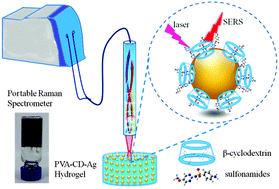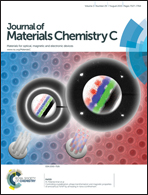Preparation of a native β-cyclodextrin modified plasmonic hydrogel substrate and its use as a surface-enhanced Raman scattering scaffold for antibiotics identification†
Abstract
It is challenging to fabricate a surface-enhanced Raman scattering (SERS) substrate for capturing targets that have weak affinity with conventional SERS substrates. Hence a new strategy is proposed by combining surface modification and gelation of Ag nanoparticles. The weak affinity between the target and the Ag nanoparticles was strengthened by β-cyclodextrin (CD) as a “bridge”, and the hydrogel structure ensured the good reproducibility and sensitivity of the substrate. In the synthesis, the CD was used as a reducing and shape-controlling agent to form CD-modified Ag nanoparticles, which were then encapsulated into a polyvinyl alcohol (PVA) hydrogel. The three dimensional self-standing PVA–CD–Ag hydrogel showed not only excellent homogeneity and reproducibility in SERS sensing, but also good recognition ability toward sulfonamides. The CD modification strengthened the affinity of sulfonamides to the Ag surface not only through a host–guest interaction drawing sulfonamides into its interior cavity, but also as a scaffold to pull analytes close to its cavity, as clarified by fluorescence and 1H NMR methods. This molecular targeting substrate was used for the trace detection of sulfonamides on a portable Raman instrument, producing detection limits as low as 10 ng mL−1. The new substrate was also used for the identification of sulfonamides from their mixture by providing their fingerprint information.


 Please wait while we load your content...
Please wait while we load your content...